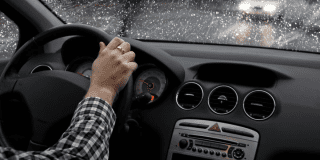Car Crashes May Drop by 80 Percent with New Technology
The U.S. Department of Transportation’s (DOT) National Highway Traffic Safety Administration (NHTSA) has its eye on the future to make the roads a lot safer, thanks to technology that will enable drivers to avoid 80 percent of most preventable crashes.
Plans are in place to improve vehicle safety by allowing vehicles to “talk” to each other by exchanging basic safety data, such as speed and position through V2V (Vehicle-to-Vehicle) communication technology for light vehicles.
The start of a new period in vehicle safety, the goal is to apply this new technology on preventing crashes versus survivability after an accident has occurred. Will this exciting technology result in a decrease in car insurance rates? We’ll just have to wait and see.
From August 2012 to August 2013, in the largest road test of V2V technology ever conducted, the DOT ran the Safety Pilot “model deployment” in Ann Arbor, Mich., using nearly 3,000 vehicles.
Proven by DOT research with ordinary drivers under both real-world and measured test conditions, safety improvements using V2V technology have been shown to identify risks and alert drivers with warnings to avoid other vehicles in common crash events, such as crashes at intersections or while changing lanes.
Facts
• Accidents caused by drunken drivers account for almost a third of the 33,500 U.S. traffic fatalities in 2012.
• Excluding drunk drivers or mechanical failure, NHTSA estimates that vehicle-to-vehicle communications could prevent almost 80 percent of all other accidents.
• NHTSA is currently finalizing its analysis of the data gathered as part of its year-long pilot program and will publish a research report on V2V communication technology for public comment.
• NHTSA will then start writing a plan that would require V2V devices as future standard safety equipment in vehicles.
• The Intelligent Transportation Society of America estimates the advanced technology would add about $100 to $200 to the price tag for each new vehicle.
How it works
• Connected vehicle systems are based on Dedicated Short Range Communications (DSRC)
• DSRC are a lot like Wi-Fi—which is fast, secure, reliable, and unlikely to be affected by interference.
• Using either in-vehicle or after-market devices that constantly share important safety and mobility information, vehicles ranging from cars to trucks and buses to trains would be able to “talk” to each other.
• The technology works up to a distance of about 300 yards.
• Your car would “see” when another car or truck equipped with the same technology was about to run a red light, even if that vehicle was hidden around a corner or sense when a car several vehicles ahead in a line of traffic suddenly stopped, alerting you even before you saw brake lights.
• Using radio signals, a transponder continually transmits the vehicle’s position, heading, speed and other information 10 times per second in all directions
• A vehicle’s computer alerts its driver to a rapidly approaching collision.
• Possible alerts:
- flashing message (sight)
- audible warning (sound)
- rumbling driver’s seat (touch)
An improvement in safety wouldn’t be seen until there are enough numbers of vehicles on the road using the technology. According to research, this could be reached with only 7-10 percent of vehicles operating in a certain area.
With V2V technology becoming available, this will definitely be a great time to get a new car insurance quote.
Do you think V2V technology will make our roads safer? Feel free to share your thoughts in the comments section below.



